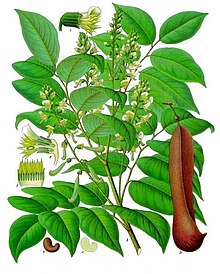Myroxylon
| Myroxylon | |
|---|---|
 |
|
| Myroxylon balsamum from Koehler's Medicinal-Plants (1887) | |
| Scientific classification | |
| Kingdom: | Plantae |
| (unranked): | Angiosperms |
| (unranked): | Eudicots |
| (unranked): | Rosids |
| Order: | Fabales |
| Family: | Fabaceae |
| Subfamily: | Faboideae |
| Tribe: | Amburaneae |
| Genus: |
Myroxylon L.f. |
| Species | |
|
|
| Synonyms | |
|
|
The genus Myroxylon was originally described in 1753 by Linnaeus, such description was made using a specimen collected in the province of Cartagena (at the time Tolú was located in the province of Cartagena), and named it Toluifera balsamum. The genus Myroxylon was first established by Linnaeus filius in 1781, when he described Myroxylon peruiferum based on a specimen collected by Mutis in South America. Latex from Myroxylon trees is the source of Balsam of Peru and Tolu balsam (which differ in production) and composition.
Some authors recognize infra-specific taxa based, mainly, in their balsam phytochemistry; while other authors do not recognize such categories. There are reports of differences in composition of balsams obtained from M. balsamum, M. balsamum (var. pereirae), and M. peruiferum.
It is in the Fabaceae (Leguminosae) family of flowering plants. There are two species, M. balsamum and M. peruiferum.
Myroxylon is a genus of tree grown in Central America (primarily in El Salvador) and South America.
Myroxylon balsamum occurs in Central America, and northern and western South America, it is fairly common in tropical forest at 200–690 m altitude. In Peru and Brazil this species is mostly associated with rivers, and sometimes grows on lateritic soil. It is found in remnants of mesophillous forest. At present it is considered as being of least concern (LC) according to CITES classification.Myroxylon peruiferum is disjunctly distributed in the Americas, from Mexico to northern Argentina and southern Brazil, though it has a wide distribution, it is not abundant within its area of occurrence. It is found in remnants of mesophillous forest and dry habitats at 540–2000 m elevation. It is considered to be Near Threatened (NT), according to CITES classification.
The trees are large, growing to 40 metres (130 ft) tall, with evergreen pinnate leaves 15 centimetres (5.9 in) long, with 5–13 leaflets. The flowers are white with yellow stamens, produced in racemes. The fruit is a pod 7–11 centimetres (2.8–4.3 in) long, containing a single seed. The tree is often called Quina or Balsamo, Tolu in Colombia, Quina quina in Argentina, and sometimes Santos Mahogany or Cabreuva in the lumber trade.
...
Wikipedia
